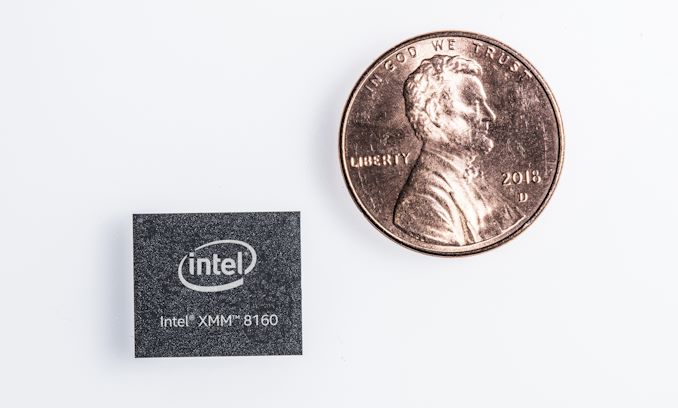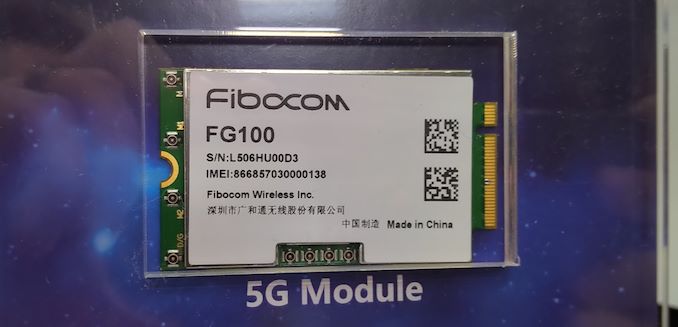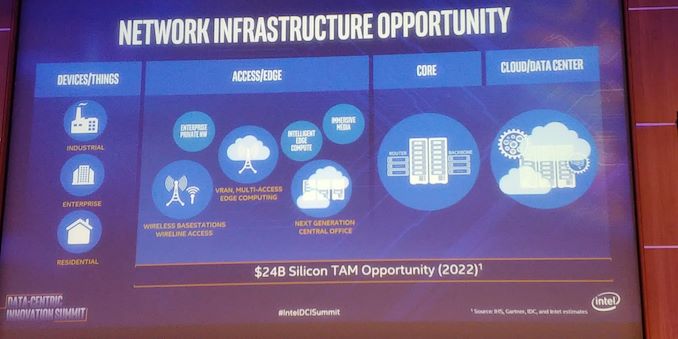Intel Exits 5G Smartphone Modem Market; Other Client Modem Businesses to Be Reviewed
by Ryan Smith on April 16, 2019 8:05 PM EST- Posted in
- Mobile
- Intel
- Smartphones
- Modem
- XMM8160

With today’s announcement out of Apple and Qualcomm that the two fierce rivals have buried the hatchet for good, the situation immediately put into question the fate of Intel’s modem business. As Intel’s only major smartphone modem patron, Apple’s business and enormous order volume made Intel’s smartphone modem business an all-or-nothing affair. Now, as Apple and Qualcomm are seemingly reconciling towards Apple once again using Qualcomm’s modems, Intel has sent out an announcement this afternoon that they are bowing out of the 5G smartphone modem market entirely.
In the brief announcement, Intel stated that it was scrubbing its plans to launch 5G modems for smartphones, including modems planned for next year, i.e. the smartphone version of XMM 8160. Intel’s rationale here, while not mentioning the Apple/Qualcomm deal, is rather simple, with Intel’s CEO, Bob Swan, noting that the company doesn’t see a “clear path to profitability and positive returns.” Without a major customer, there won’t be an opportunity for Intel to make back their R&D costs.
Note however that this doesn’t mean Intel is getting out of smartphone modems entirely, at least not right away. The company’s announcement is also making it clear that Intel will continue delivering 4G modems to current customers (e.g. Apple) to meet their sales commitments. So while we won’t see any Intel-powered phones in the 5G era, Intel will remain a fixture in the 4G era – at least as long as Apple keeps buying modems from them.
Meanwhile Intel is also announcing that alongside canceling their smartphone modem plans, they’re also going to use this opportunity to reevaluate the rest of their client modem portfolio. Intel’s plans for the XMM 8160 took it well beyond smartphones, with plans for putting it in devices like PCs and broadband access gateways as well. Now the company needs to figure out if these plans still make sense – if the XMM 8160 will be competitive in these markets, and if continued development and manufacturing make sense without a large smartphone customers. At this point Intel faces an uphill battle in the rest of the client modem market, and there’s a very good chance that Intel’s reevaluation will find that there’s no place for the company in this highly competitive market.
Interestingly however, while Intel is on a path to throwing in the towel on client 5G entirely, the company is also making it clear that they intend to stay in the lucrative 5G infrastructure market, and that today’s announcement is only about client products. To use Intel’s favored buzzword here, the company is still driving hard on its data-centric approach to chips, which means they continue to be invested heavily in servers, infrastructure, and AI.
Ultimately, if this is to be the end of Intel’s client modem business, it’s certainly been one heck of a ride for the group. After supplying modems for all of Apple’s 2G and 3G iPhones as Infineon’s wireless solutions group, the modem business was sold to Intel in 2011, who largely struggled with the business since then. Intel’s 4G modems were late to market, and there are still debates over whether they’re as good as the best 4G modems available today. As a result, Intel was never able to recapture the same kind of success the group saw in the 2G/3G era.
Source: Intel












28 Comments
View All Comments
flgt - Tuesday, April 16, 2019 - link
They checked their twitter account and realized they were supposed to be on 6G, and abruptly gave up.PaulHoule - Tuesday, April 16, 2019 - link
How much money did Intel spend claiming that they are "the leader in 5G?" Like, winning that "race" everybody keeps talking about although nobody seems to know or care where the finish line is.FunBunny2 - Tuesday, April 16, 2019 - link
I'm willing to bet this old bridge over the East River that there's never going to be Real 5G, aka mmWave, anywhere but very dense populations. the carriers are already lying about their '5G' offerings. Intel only, I'll guess, needs to accommodate the LTE+ bands that are being passed off as '5G'. just like everybody else.PaulHoule - Wednesday, April 17, 2019 - link
The millimeter wave story does not make sense for handsets at all. Most mobile data is consumed indoors, Cisco says 80%. If you look at places like St. Mark's Square in New York City the walls of many ofthe buildings are studded with antennas, there is already some massive MIMO going on.
If they add millimeter wave to the mix they are only addressing outdoor users who are just
20%. It doesn't relieve the bottleneck, which is indoors. If you combine it with other technology you might plug the gap but then there isn't much point in providing mmwave service outdoors.
The research I have seen shows that mmWave is the bomb when it comes to fairly long
(10m-10km) point-to-point links that you'd see in a fixed wireless application. The model that makes the most economic sense is the "webpass" model where you put up a few super-towers on some big buildings and then connect to them with directional antennas on big apartment buildings. You can probably offer cable-class service for $30-$40 a month that way in a few random places where the economics are good.
Mobile companies though, aren't much more interested in competing with the cable companies than the cable companies are in competing with each other. Sub-1GHz services, however, might be able to beat DSL in "exurban" areas. I published some results about how I could get about the same down and better up than my DSL and not long after, Frontier bumped me up to 4Mbps on two lines.
FunBunny2 - Wednesday, April 17, 2019 - link
"The model that makes the most economic sense is the "webpass" model where you put up a few super-towers on some big buildings and then connect to them with directional antennas on big apartment buildings. "that's how microwave transmission was used for decades: long distance telephone over mw towers. I understand they're still standing and are used? not sure about that last bit.
PaulHoule - Thursday, April 18, 2019 - link
They are still standing. In my area (upstate NY) many of them are owned by American Tower. The microwave horns are usually still up but not in use. The capacity of optic fiber today is so much greater.Hypothetically American Tower leases space out on the towers for cell phones and similar uses but they are not such a hot commodity and I don't see many antennas on them that look recent.
mmWave systems would probably involve a phased array antenna at the base station which could cast tight beams at customers, customers would probably have a simpler antenna but possibly with a few sub-antennas for MIMO action.
FunBunny2 - Thursday, April 18, 2019 - link
"If they add millimeter wave to the mix they are only addressing outdoor users who are just20%."
and a second, or so, re-read twerks a lower brain stem memory. recall that, at one time, we would all be using Moto's (the real one) satellite phones? turns out, they only work outdoors. deja vu all over again.
PaulHoule - Thursday, April 18, 2019 - link
I remember being excited about Iridium but it took longer to deploy than was anticipated, and by the time it was ready, there was cell phone service in most of the places where people go, thus it served a tiny market.edzieba - Wednesday, April 17, 2019 - link
Or for the more cynical: how much did Apple pay Intel to /appear/ to have a 5G program whilst the Qualcomm litigation was ongoing?name99 - Friday, April 26, 2019 - link
Uh, wot?Apple's stance during the trial was that the way QC licenses patents REDUCES competition in this space. Having Intel selling modems weakens Apple's case, not strengthens it!
But don't let reality, or common sense, get in the way of your Apple bashing...